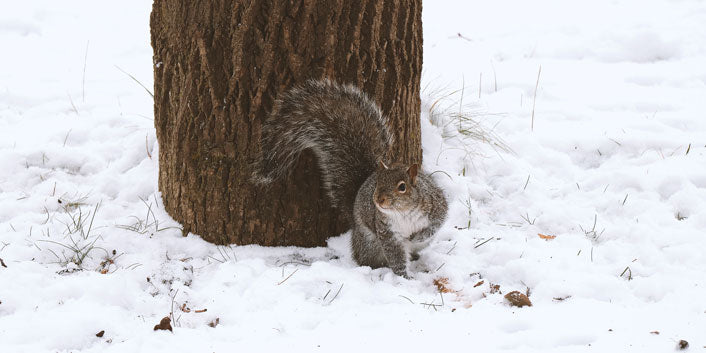How Do Squirrels Survive Winter Without Hibernating

When the weather starts to get crisp in the fall, you might notice local squirrels start putting on some pounds. This "fattening up" for winter reminds many people of what bears do as they prepare for hibernation. While tree squirrels have a few behaviors that help them survive winter, they don't actually hibernate. You'll see them running around in all seasons, so it's crucial to be wary of them and protect anything they may claw and damage year-round.
What Is Hibernation?
Within the animal kingdom, there are several terms that refer to the slowing of an animal's metabolism. Insects have what's called diapause, an extended period of extreme inactivity that can last several years, as in the case of cicadas. Hummingbirds go into torpor, a state that occurs every night so that the hummingbird can survive in between feedings. Hibernation is the long-term version of torpor; a hibernating animal slows its heart rate, lowers its body temperature, and reduces non-vital physiological processes. Unlike insects in diapause, a hibernating animal periodically becomes active to meet its (reduced) needs for food and water. It's clear that the strategy of slowing one's metabolism is evolutionarily very successful. So, why don't squirrels hibernate, and how do they survive the winter, especially with the recent polar vortex?
A Squirrel's To-Do List
In animals, seasonal changes are tracked by the photo-neuroendocrine system, a sensitive collection of glands, hormones, and neurons that are wired to adjust our internal chemistry as the length of a day changes. When the photoperiod begins to shorten in the fall, squirrels take notice.
Build a Nest
Squirrels sleep in nests year-round, but a nest or cavity den is essential for squirrels to stay nice and toasty in the winter. Nests are often built out of twigs, leaves, and moss in tall trees, although a squirrel won't turn down your home's attic to build its nest. Cavity dens are usually found in hardwood trees where woodpeckers or other animals have left holes. Throughout the year, a squirrel may have multiple nests and cavity dens to help it evade predators and bad weather.
Collect Supplies
Tree squirrels are surprisingly clever about how they store their food for the winter. Rather than keeping it all in one place, they spread it out around their nests; this is called "scatter hoarding." They also may pretend to bury something in one place and then actually bury it somewhere else to throw off competitors! Squirrels eat a variety of nuts, seeds, berries, insects, and even bones. In the winter, squirrels return to their buried hoards during the day. It seems that they're able to remember where their food is by using a technique called "spatial chunking," where they bury similar types of foods in similar places.
Build Up Fat Reserves
Just as they store food underground for use during the winter, squirrels store fat on their bodies in preparation for the cold. When food is scarce, a good layer of fat offers the energy a squirrel might need to survive. It also helps them stay warm when the temperature drops.
Squirrels are industrious creatures, so that while other animals are hibernating, they can keep scampering about in the cold season. They'll run up and down utility poles to get to their stashed food. Squirrels stick around all year, so protecting your power lines from their clawing paws is always important. Critter Guard's Pole Guard and Line Guard protectors block squirrels from accessing your roof or attic and prevents costly power outages. Contact us to learn more about protecting your home and utilities today.
- Choosing a selection results in a full page refresh.


